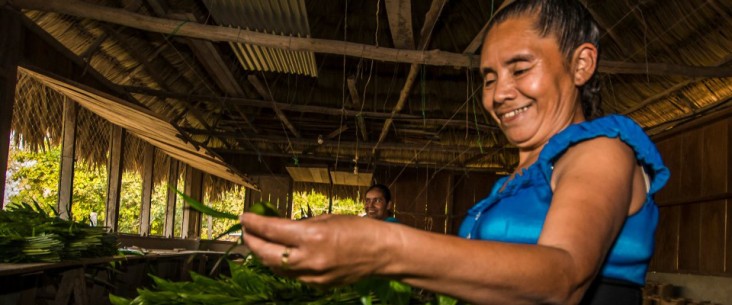Speeches Shim

“The rainforest is the most powerful and generous giver – we have to look after her to ensure she is with us forever... That is something I have taught my children,” Jorge Soza Chi, FORESCOM director, Petén, Guatemala
With USAID support, the advance of the agricultural frontier has slowed and the massive internal migration of Guatemalans has been absorbed into settled areas within the Reserve. More fragile areas are under government protection set apart as restricted natural habitats.
The Mayan Biosphere Reserve
At 2.1 million hectares and covering twenty percent of the country’s area, the Mayan Biosphere Reserve (MBR) in Guatemala’s northern Peten is the centerpiece of the largest block of broadleaf tropical forest in Mesoamerica. This natural protected area is one of the most ecologically diverse on the planet and is home to numerous ancient Mayan sights of significant cultural importance. The MBR is also a critical part of Guatemala’s tourism industry and is generally considered essential for Guatemala’s economic and environmental wellbeing.
Like other tropical forest systems around the world, the MBR is threatened by some key drivers, most notably shifting cultivation, habitat loss, overexploitation, wildlife trafficking and weak governance. Because the MBR is so vast, innovative approaches to forest and biodiversity conservation that are most effective are placing rural Indigenous and traditional communities already living in and around protected areas at the center of these efforts, resulting in benefits to communities and providing opportunities for Indigenous Peoples to influence development programming in line with their own goals.
Conservation Enterprise Approaches – Healthy Forests, Healthy Profits
Conservation enterprise approaches promote alternative forest-based livelihoods that enable rural poor to generate income from maintaining the forest, while reducing deforestation and enhancing biodiversity conservation. In the case of USAID’s programming in the MBR, conservation enterprise approaches have demonstrated how harvesting and marketing forest products from healthy forests generate increased, sustainable incomes for households and communities. Women and men manage forest concessions as small community businesses and receive training and skills in forest management, product certification and marketing and financial management that make these enterprises self-sustaining and effective in promoting forest conservation.
Community concessions have developed a number of forest product value chains including timber, xate palm, chicle gum and allspice, in addition to the provision of cultural and ecotourism services. Community concessions may also generate payments for ecosystem services. NTFPS and non-timber activities also provide an important income source for women and other residents that may not be concession members, as these activities do not directly disrupt commercial timber interests. Additionally, extending benefits for non-members in the community has helped improve compliance with regulations in USAID project areas.
Key lessons learned on stakeholder benefits resulting from USAID-supported conservation enterprises in the MBR include:
- Diversification and value-added supply chains help maximize returns and spread benefits to a greater number of community members, particularly in the case of non-timber forest products (NTFPs);
- Relying on traditional decision-making structures and other social systems promotes transparency and accountability to sustain benefits over the long-term;
- Creating a revolving fund for investment in enterprise development can lead to better returns in a creatively short period of time in comparison to paying out all profits as dividends
Jorge’s Story
Jorge [Soza] has a lifetime of experience in the forests of Peten, first as a child, then working in chicle production and later as the president of FORESCOM, Guatemala’s community forestry organization. Jorge oversees 25 year concessions that, when managed in concert with local communities, attempt to balance conservation and economic development.
As a leader in the communities of Peten, Jorge has helped catalyze a “fundamental change in mindset” in which communities view forests not only as their responsibility, but as a job and a means of conserving important natural and cultural resources for generations to come. With the support of USAID and Jorge’s entrepreneurial mindset, including implementation of an improved management structure and updated accounting practices, the concessions of the MBR are generating in excess of $7 million USD annually from timber and non-timber forest products. Due in part to Jorge’s leadership, FORESCOM also became the first community forest enterprise in Guatemala to fully cover its costs from the fees it collects. Community members routinely request advisory services in forest management and business planning.
Job creation in and around the MBR – numbering in the tens of thousands of permanent and temporary jobs – makes it possible for communities to see future forest management through an entrepreneurial lens, and with the support of visionary, dedicated leaders like Jorge, the link between healthy forests and economic development will continue to be reinforced for decades to come.

Comment
Make a general inquiry or suggest an improvement.